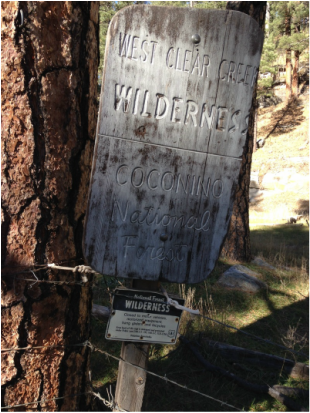Still, I wonder what it means that to be behind this sign, behind this permeable boundary represented by barbed wire (barbed wire, of course, is the quintessential symbol of civilization for every westerner). What does it mean to the tree in front of this sign versus one of the pines behind it? Do foraging elk care what this barbed wire represents? Do the bear?
“Wilderness” is defined by an online dictionary as “a wild and uncultivated region, as of forest or desert, uninhabited or inhabited only by wild animals; a tract of wasteland” (dictionary.com). According the Wilderness Act of 1964, “A wilderness, in contrast with those areas where man and his own works dominate the landscape, is hereby recognized as an area where the earth and its community of life are untrammeled by man, where man himself is a visitor who does not remain.”
Such definitions fit the legal designation, the denotative meaning of the sign, but there is another meaning of wilderness, a more connotative definition that hinges on the root word “wild.” That which is wild is natural and unrestrained, and how can a state restrain through barbed wire borders that which is properly, by definition, unrestrained? Doug Peacock, author of Grizzly Years, used a different definition, saying “it ain’t wilderness unless there’s a critter out there that can kill you and eat you.” I love this definition.
This is not to suggest that there is something morally superior about being mauled by a bear, but that there may be something morally superior in choosing to tread where one is not guaranteed of being the apex predator. Here is the psychological value of wilderness for mankind, especially in the highly complex, technologically driven cultures of first-world nations.
It’s good for the state to designate land as “wilderness” in order to protect it from the ravages of civilization, both the rapacious industries of logging and mining as well as the well-intentioned consumption of RV campers. But don’t be fooled; it’s not really wilderness until you feel the hairs on the back of your neck stand on end.

 RSS Feed
RSS Feed
